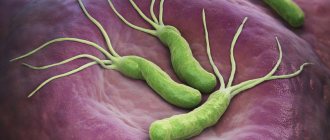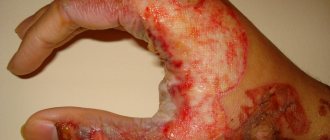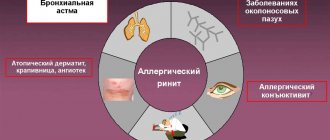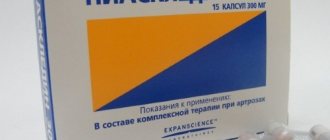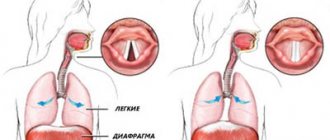Useful articles / August 8, 2019
People are accustomed to blaming unhealthy food and stress for the occurrence of gastritis and ulcers, although in fact most problems with the gastrointestinal tract are due to the insidious bacterium Helicobacter pylori.
Helicobacter pylori is a spiral-shaped parasitic bacterium that can penetrate the mucous membrane of the stomach and duodenum. It produces toxins that affect the mucous membrane of these organs and cause pathological changes. The peculiarity of Helicobacter pylori is that the aggressive acidic gastric environment is a very comfortable habitat for it. And, if most bacteria die in such an aggressive environment, then Helicobacter adapts well to it. According to statistics, more than 80% of the Russian population is infected with this bacteria.
To accurately diagnose and prescribe treatment for gastrointestinal problems, the patient must be tested for the presence of the bacterium Helicobacter pylori in the body . What laboratory diagnostic methods exist today and how accurate are they?
What kind of bacteria is this?
Helicobacter pylori - translated from Latin - is a spiral-shaped bacterium that lives in the pylorus. And indeed the microscopic bacterium looks like a spiral surrounded by hairs. With the help of these hairs - flagella, it quickly moves through the internal organs to its place of permanent residence - the pylorus - the lower tier of the stomach and the initial section of the intestine - the duodenal bulb. The Helicobacter bacterium has refuted the myth that hydrochloric acid in the stomach kills all microbes. On the contrary, the little predator feels at home in destructive acid, thanks to the enzyme urease, which breaks down hydrochloric acid.
How does Helicobacter affect the stomach? Destroys parietal (parietal) cells of the mucous (inner) lining of the stomach, releasing toxic products - toxins. Protective blood cells - neutrophils, lymphocytes and others - pursue the pest, trying to destroy both it and the altered parietal cells - inflammation occurs. The amount of protective mucus in the area where the bacterium resides is noticeably reduced, and hydrochloric acid rapidly affects the altered area, exacerbating the constant inflammation of the mucous membrane. This is manifested by pain in the stomach “in the pit of the stomach,” heartburn, belching, coating on the tongue, bad breath, constant nausea, that is, symptoms of chronic gastritis. Chronic long-term inflammation of the gastric mucosa leads to changes in its cells, including the development of stomach cancer.
How does Helicobacter enter the body? Since Helicobacter lives in the stomach, infection is possible when the bacteria enters the human body through the mouth. This is the habit of taking food or dishes with unwashed hands, and the desire to try food on someone else’s plate or take a bite from an apple or a friend’s sandwich when offered to try - this is how children often become infected. In addition, you can become infected by sharing utensils or through kissing, which is why Helicobacter is often found among members of the same family.
So why now go to a cafe with your own dishes? Fortunately, Helicobacter is not a resistant bacterium and washing dishes in the dishwasher is enough to destroy them. Good restaurants and cafes are of course equipped with such machines, and you can visit them without the risk of infection.
Bismuth preparations and proton pump inhibitors in the treatment of Helicobacter
De-nol is a bismuth-based medicine.
A bismuth-based drug, De-nol, was used even before the discovery of the pathogenic microorganism. It has an enveloping effect, forming a film on the gastric mucosa.
It protects the walls from the aggressive effects of hydrochloric acid. After the discovery of Helicobacter, it turned out that bismuth subcitrate has an inhibitory effect on the bacterium. It is able to penetrate into the deep layers of the mucous membrane, where the pathogen likes to settle.
Proton pump inhibitors - Omez, Omeprazole, Pariet - block areas of the mucosa responsible for the production of hydrochloric acid. This promotes the healing of erosions, reduces the acidity of gastric juice and allows the antibiotic molecules to be preserved in an acidic environment.
How do I know if I have Helicobacter pylori infection?
The presence of insidious bacteria in the body can be detected in different ways. First of all, this is a histological method, when during FGDS (fibrogastroduodenoscopy) - an examination of the stomach, which can be carried out in Chelyabinsk at the All Medicine Clinic - cells of the gastric mucosa are taken for examination. Not only the bacterium Helicobacter pylori is detected, but the condition of the inner lining of the stomach is also assessed - the severity of inflammation and the degree of change in mucosal cells against the background of inflammation. The following methods are breath tests. Helicobacter produces the enzyme urease, which is capable of decomposing urea to form ammonia and carbon dioxide. The essence of the methods is to determine either the composition of carbon dioxide in the patient’s exhaled air (urease breath test) or ammonia (Helic test). The Helic test is quite widely used, especially in pediatric practice, as a simple, non-invasive diagnostic method for the patient. Another common diagnostic method is the detection of specific antibodies of class G immunoglobulins - IgG in the patient’s blood. Helicobacter pylori infection is accompanied by the development of an immune response - the production of antibodies, of which IgG occurs in 95-100% of cases. This is a reliable diagnostic method that allows you to assess the degree of Helicobacter contamination, but not the best way to control the treatment of Helicobacter pylori infection, since the level of IgG antibodies can remain high after the complete death of the microorganism for a long time - 1-1.5 years. In this case, if an antibody test is nevertheless performed, a decrease in their level is assessed no earlier than 2-3 months after the end of treatment. More often, to monitor the effectiveness of treatment for Helicobacter pylori infection, a stool test is performed. It is based on the detection of Helicobacter DNA in feces and is qualitative - it shows whether Helicobacter is detected or not, without assessing the degree of contamination. The method can also be used to diagnose the presence of infection before treatment, for example, in children, as it is simple and painless.
How is the Helicobacter test interpreted?
If the research is qualitative, then there can be only two results - “positive” or “negative”. If a quantitative method is used, the analysis standards will depend on the specific laboratory, and only a doctor can interpret them.
How can you become infected with Helicobacter pylori?
The bacterium Helicobacter pylori is called an intrafamilial infection and it occurs in 80% of the Russian population. The main modes of transmission: fecal-oral, oral-oral, household. This could be kissing, sharing utensils, eating insufficiently clean vegetables and fruits, failure to comply with personal hygiene rules... Most often, infection occurs in childhood through household contact. If, for example, parents have the bacterium Helicobacter pylori in their bodies, then it is passed on to their children. Another question is in what period of a person’s life it will manifest itself. Do not forget that most diseases of the upper digestive tract occur precisely because of this bacterium. Gastroenterologists warn that 100% of people with Helicobacter develop gastritis over time. Therefore, it is important to detect it and undergo treatment on time.
I have been diagnosed with Helicobacter pylori – what should I do?
If a positive test for Helicobacter pylori is detected, you should consult a gastroenterologist or therapist. Antibiotics are used to treat infection, and only a doctor prescribes them.
Is it possible to cure Helicobacter by taking the drug de-nol, as shown in advertising, or with folk remedies? You can completely get rid of Helicobacter pylori infection only with certain antibiotics.
Do I need to treat myself with antibiotics if nothing bothers me and the test result for Helicobacter is positive? The infection may not bother you, in 70% of cases this happens, gastritis proceeds “silently” for years, but after a few years, due to low-grade inflammation, atrophy of the mucous membrane occurs and its transition to stomach cancer cannot be ruled out. In each specific case, the decision to carry out treatment is made by the attending physician.
Helicobacter pylori infection is very common among the population, is there any point in treatment if you can become infected again later? Yes, re-infection is possible, but it does not happen often - approximately 6 people out of 100 treated people acquire the infection again if the rules of prevention are not followed. They are very simple - wash your hands before eating, don’t try other people’s food, don’t eat in dubious eateries where you can’t be sure of the correct handling of the dishes, don’t kiss people you’re not very close to. It is also important, when a Helicobacter pylori infection is detected, to test all family members for it, starting from adolescence, and ideally, to treat all infected people at the same time. Children, if nothing bothers them, are treated from adolescence - from 12-13 years. If a child complains of abdominal pain or nausea, then examination and treatment are carried out according to indications at an earlier age.
People very often complain about exacerbation of gastritis. But in many cases it can be cured by getting rid of the bacteria that caused the inflammation of the stomach. If the infection is left unattended, over time, gastritis will turn into atrophic. Then the patient will need to take a biopsy at least once a year in 5-7 places of the stomach in order not to miss cancer.
Traditional medicine and Helicobacter
Traditional medicine recipes should not be used without consulting a doctor.
What does traditional medicine offer for the treatment of Helicobacter? Recipes are often contradictory:
- Raw chicken eggs. It is recommended to drink 1 raw egg before breakfast. This should normalize the normal microflora of the stomach.
- St. John's wort, calendula and yarrow are mixed in equal proportions. Make a decoction - 250 ml of water per 5 g of mixture. Take the infusion 0.5 cups 3 times a day for a month.
- It is recommended to consume 1 teaspoon of rosehip syrup per month.
- Flaxseed decoction. For 1 tablespoon of seed you will need 1 glass of water. Simmer over low heat for 20 minutes. Strain the broth and take 1 tablespoon before each meal.
The use of traditional medicine recipes should only be started after consulting a gastroenterologist. Otherwise, within a month of treatment you risk getting a perforated ulcer with all the ensuing consequences.
References
- Ivashkin, V.T., Maev, I.V., Abdulganieva, D.I. etc. Practical recommendations of the Scientific Community for Promoting the Clinical Study of the Human Microbiome (NSOM) and the Russian Gastroenterological Association (RGA) on the use of probiotics for the treatment and prevention of gastroenterological diseases in adults. Russian Journal of Gastroenterology, Hepatology, Coloproctology, 2021. - T. 30.
- Guevara, B., Cogdill, A. Helicobacter pylori: A Review of Current Diagnostic and Management Strategies. Dig Dis Sci., 2021. - Vol. 65(7). – P. 1917-1931.
- Choi, I., Kim, C., Lee, J. Family History of Gastric Cancer and Helicobacter pylori Treatment. N Eng l J Med., 2021. - Vol. 382(5). — P. 427-436.
- Nagy, P., Johansson, S., Molloy-Bland, M. Systematic review of time trends in the prevalence of Helicobacter pylori infection in China and the USA. GutPathog., 2021. - Vol. 8.
- Alem, M., Alem, N., Cohen, H. et al. Diagnostic value of detection of IgM antibodies to Helicobacter pylori. ExpMolPathol., 2002. - Vol. 72(1). — P. 77-83.
Endoscopy
It is considered the most reliable and “reference” method for diagnosing Helicobacter pylori infection. There is a rapid mucosal biopsy test, where the presence of bacteria is determined on the spot. And there is a histological examination. A biopsy specimen must be taken from different parts of the gastric mucosa. This is an in-line, but very reliable method that allows you to determine the nature of the biopsy cells: whether there are tumor processes or inflammation in the tissue; what is the nature of mucous secretion? It also allows you to determine whether it is atrophic or ordinary gastritis.
There is some skepticism regarding revolutionary methods such as capsule endoscopy. This is a popular and comfortable method, but a capsule with a microvideo camera, passing through the gastrointestinal tract, may not show all its departments. In difficult cases, it can get stuck in hernias, protrusions, and diverticula. Or maybe you won’t even notice them. It is also not possible to take a biopsy specimen for examination using this capsule.
"Gold standard" of diagnostics
First, to choose a treatment strategy, you need to make a correct diagnosis. There are many methods - from endoscopic to small, tablet-sized video cameras. The patient tries to choose the most comfortable option for himself and his wallet; there are certainly few daredevils who are ready to voluntarily undergo gastroscopy. A comfortable and painless method with sedation is not financially accessible to everyone; now such a complex costs about 10 thousand rubles. It is painless and informative, but even among wealthy patients there are many who are “afraid of anesthesia.”
Breath test - definition and its types
A breath test to detect Helicobacter pylori is a diagnosis of infection that allows you to identify the activity of Helicobacter pylori and assess the level of infection. Gastroenterologists, therapists, and pediatricians often use it in their practice. The Helicobacter pylori breath test is used for the initial diagnosis of the bacterium. They are also used to monitor the treatment process of the disease and check the effectiveness of therapeutic treatment.
The method is absolutely safe, the most effective and in demand in medicine today. The analysis shows the waste products of bacteria in the air that the patient inhales.
There are two main types of method. They differ in the reacting component:
- carbon
- ammonium
Carbon breath analysis provides a more accurate result.
Advantages and disadvantages of the method
This respiratory method has its advantages:
- The result is ready in a short period of time (20-25 minutes).
- Reliability of the result is 90-95%.
- The test does not harm the human body.
Since the method has only advantages, it has no contraindications. But the result will be accurate only if you prepare for the test correctly.
Preparing for a breath test
In order for the test to give the most accurate results, special preparation for the breath test is recommended:
- one month before the test, you should not take antibiotics;
- three days before the examination, do not drink legumes and alcoholic beverages;
- 6 hours before the test, do not eat anything;
- 14 days before the examination, avoid taking drugs that suppress the course; physiological and enzymatic processes in the body;
- You can’t chew gum or smoke for a few hours;
- the last meal no later than 22 hours, it should be a light dinner;
- one hour before the examination you can drink no more than 10 ml of water;
- for the analysis result to be accurate, the patient should not move;
- Before the examination, thoroughly clean your teeth and mouth.
It is very important to prepare for the test correctly, otherwise you will not get an accurate result. If the patient was unable to comply with all the rules, he must inform the doctor about this and another time will be assigned to him.
How the test is carried out
The procedure is carried out in a hospital setting under the supervision of a specialist. If the examination is carried out using a tube, the manipulation lasts no more than 15 minutes. If an electronic device is used, the procedure time is 10 minutes.
The procedure is simple:
- the patient takes a comfortable position
- a plastic tube is placed in the mouth, and breathing should be normal
- it is advisable not to touch the tube with your tongue and palate so that saliva does not get there
- if saliva accumulates, you can spit it out or swallow it, pull out the tube and take an air sample
- the first stage of manipulation lasts 6 minutes
- the patient is given a carbamide solution to drink
- the tube is placed back in the mouth
- the second stage also lasts 6 minutes, air testing is carried out
- after this the result is displayed.
Interpretation of analysis results and normal indicators
The norm is when the difference between the indicators of the first and second stages of the survey is zero. If there is Helicobacter in the body, the indicator will be above zero.
With the indicator:
- trace value is 1.5 -3.5, the microorganism is in an inactive phase and can be quickly gotten rid of;
- 3.5 - 5.5 – low level;
- small - up to 7 ppm;
- from 7 to 15, the bacteria is in the active phase, multiplying, the treatment process becomes difficult;
- above 15 – high level of contamination.
With any positive result, therapy should be started immediately, this will avoid complications and pain. But the Helicobacter treatment regimen must be drawn up by a doctor.
Contraindications for carrying out
The method has no contraindications, as it does not include any interventions or stress. It can be used for everyone, without restrictions.
Come to us again!
At the stage of prescribing a treatment regimen, communication between the patient and the doctor usually ends. Especially if the unpleasant symptoms have disappeared. The patient saves time and money - after all, “nothing hurts.” This is the wrong tactic.
After completing the course, you need to see if it is effective. This is not done in 90% of cases. 2 weeks after completing therapy, you must test your stool for Helicobacter pylori antigen. Negative - everything is fine! If the result is positive, then at any, even minimal concentration, one must admit that the therapy was ineffective and select a new one.
The incurability of Helicobacter pylori is a medical myth. Due to the fact that patients do not take a control test and then, for example, return a year later with the same complaints and are again diagnosed with Helicobacter pylori, it is impossible to understand whether this is a re-infection or ineffective therapy. Helicobacter pylori is an infection, a microorganism. No microorganism – no problem.
At the same time, one should not miss the presence of resistance, due to which the first line of therapy may be unsuccessful. There is a problem with resistance, and in this case, correct diagnosis and a mandatory follow-up visit after treatment are very important.
